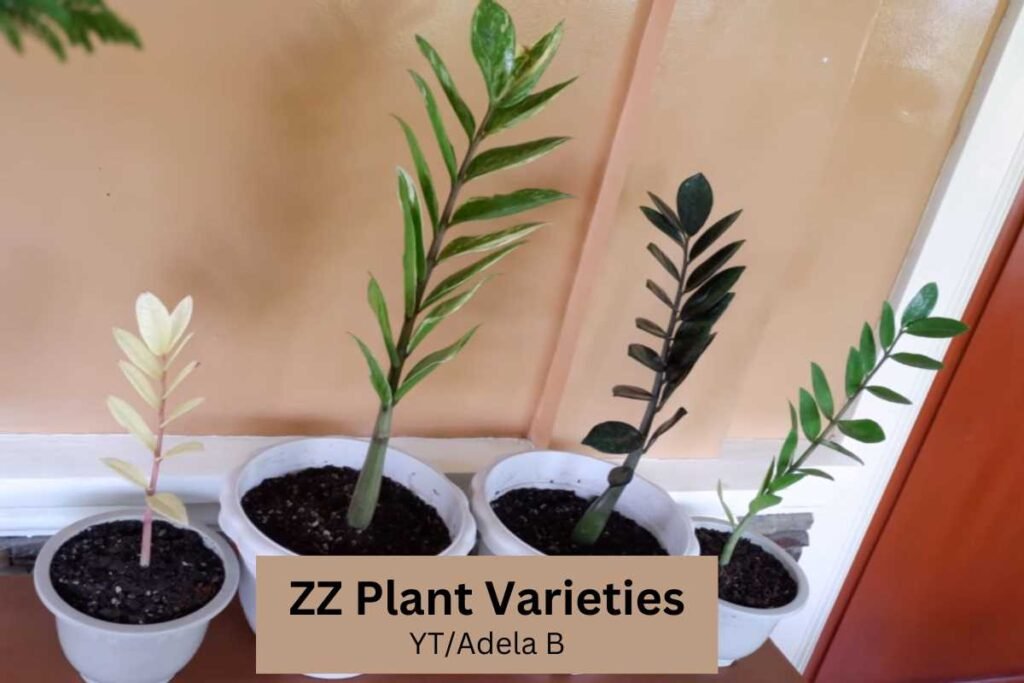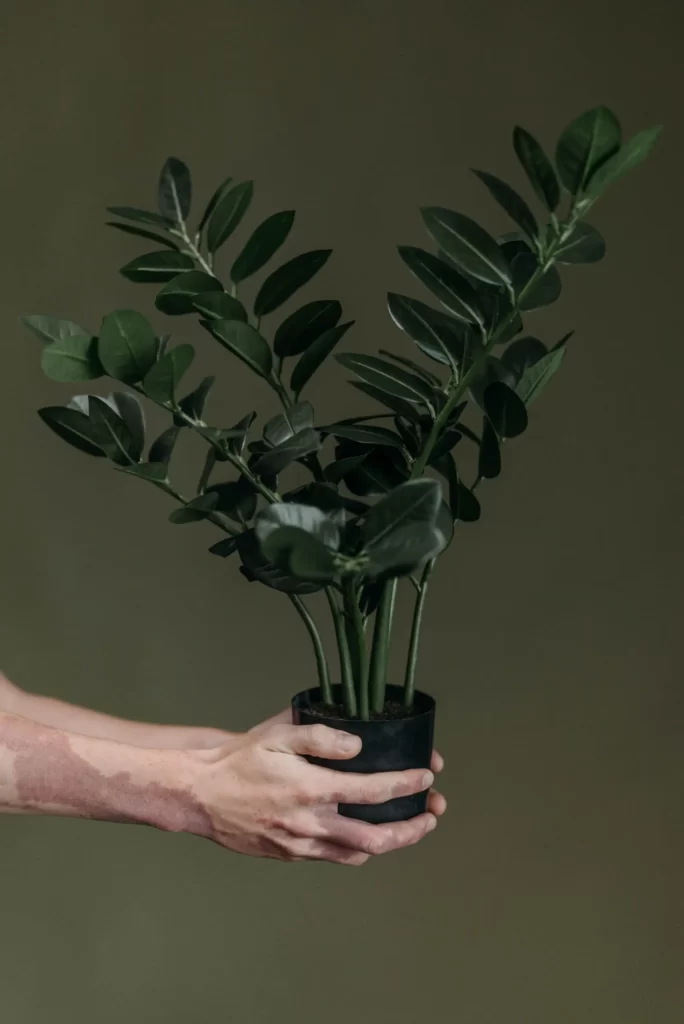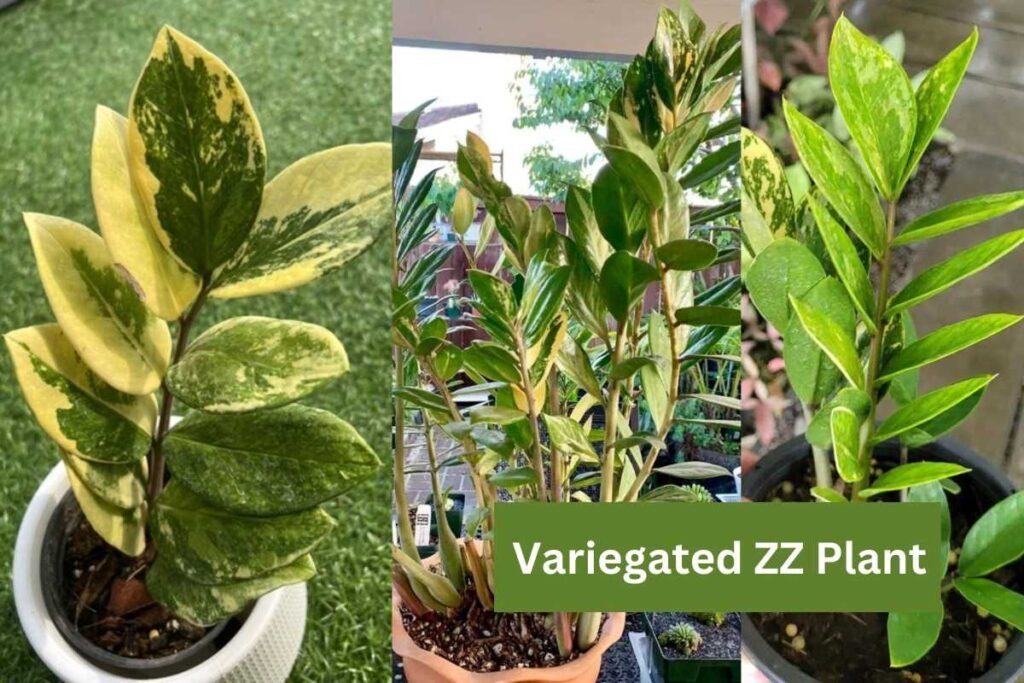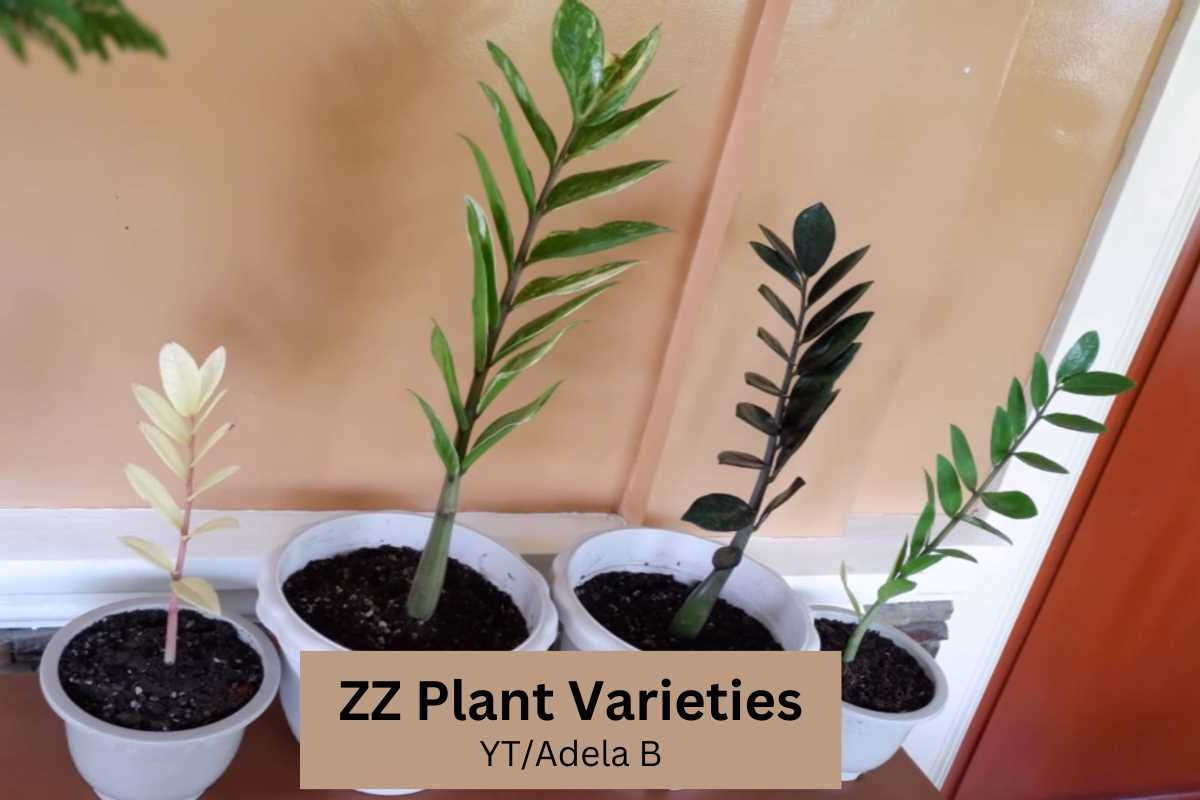The ZZ plant, scientifically known as Zamioculcas zamiifolia, hails from the tropical regions of Eastern Africa. Renowned for its resilience and adaptability, the ZZ plant has become a favored choice among houseplant enthusiasts. Its ability to thrive in low light and withstand neglect makes it an ideal plant for both novice and seasoned gardeners. The ZZ plant’s signature feature is its glossy, dark green leaves, which not only add an aesthetic appeal but also contribute to its robust nature.
Originating from areas with challenging growing conditions, including drought and low light, ZZ plants have evolved to become remarkably hardy. This resilience has translated well to indoor environments, where they continue to flourish with minimal care. The plant’s rhizomatous roots store water, allowing it to survive prolonged periods of dryness, a trait that underscores its low-maintenance reputation.
What sets the ZZ plant apart is its versatility in form. While the classic ZZ plant is widely recognized, there are several intriguing varieties that offer unique characteristics and visual appeal. These zz plant varieties, each with its distinct traits, cater to diverse aesthetic preferences and growing conditions. In the subsequent sections, we will delve into six fascinating types of ZZ plant, exploring their unique features and care requirements.
As we embark on this comprehensive guide, we aim to provide valuable insights into the world of ZZ plants. Whether you are a homeowner looking to enhance your indoor greenery or a plant enthusiast eager to expand your collection, understanding the different types of ZZ plant will help you make informed choices. Join us as we explore the captivating varieties of this resilient and visually striking houseplant.

Variety 1: Zamioculcas Zamiifolia ‘Raven’

The Zamioculcas Zamiifolia ‘Raven’, often referred to simply as the Raven ZZ plant, is a standout among zz plant varieties due to its unique dark purple-black foliage. This striking coloration makes it a popular choice for those looking to add a dramatic touch to their indoor plant collection. The Raven ZZ plant follows a similar growth habit to the standard Zamioculcas Zamiifolia, with its characteristic upright, glossy leaves emerging from thick, fleshy rhizomes.
One of the most notable features of the Raven ZZ plant is its foliage color transition. New leaves typically start as a bright green before gradually darkening to the signature deep purple-black hue over several weeks. This transformation adds a dynamic visual element to the plant, ensuring it remains an eye-catching piece year-round.
In terms of care requirements, the Raven ZZ plant is relatively low-maintenance, similar to other types of zz plant. It thrives in a range of lighting conditions, from low to bright indirect light. However, its dark foliage can handle lower light levels better than its green-leaved counterparts, making it an excellent choice for dimly lit spaces. Direct sunlight should be avoided, as it can scorch the leaves and affect their coloration.
The watering schedule for the Raven ZZ plant should be infrequent, as the plant is highly drought-tolerant. It is essential to allow the soil to dry out completely between waterings to prevent root rot, a common issue with overwatering. Typically, watering every 2-3 weeks is sufficient, but this can vary depending on the environmental conditions.
Special considerations for the Raven ZZ plant include ensuring it is planted in well-draining soil and a pot with drainage holes to facilitate proper water flow. Additionally, while the plant is generally pest-resistant, it is still advisable to check periodically for any signs of common indoor plant pests, such as spider mites or mealybugs.
Overall, the Zamioculcas Zamiifolia ‘Raven’ is a fascinating variety that stands out due to its unique foliage and ease of care, making it a cherished addition to any plant enthusiast’s collection.
Variety 2: Zamioculcas Zamiifolia ‘Zenzi’
The Zamioculcas Zamiifolia ‘Zenzi’, commonly referred to as the ‘Zenzi’ ZZ plant, is a unique variant known for its compact growth habit and smaller, denser leaves. This specific type of ZZ plant is particularly favored for small spaces and office environments due to its manageable size and appealing aesthetic.
The ‘Zenzi’ variety stands out with its lush, dark green foliage that is more tightly clustered compared to its larger counterparts. The leaves are thick and glossy, contributing to an overall robust and healthy appearance. This compact form makes it an ideal choice for tabletops, shelves, and other areas where space is at a premium.
One of the key reasons the ‘Zenzi’ ZZ plant is popular is its relatively low maintenance requirements. Like other types of ZZ plants, the ‘Zenzi’ thrives in a variety of light conditions, from low to bright indirect light. However, for optimal growth, it is best to provide it with bright, indirect light. This ensures the foliage maintains its vibrant color and compact form.
When it comes to watering, the ‘Zenzi’ ZZ plant prefers a more conservative approach. Allow the soil to dry out completely between waterings to prevent root rot, a common issue for overwatered ZZ plants. In general, watering once every two to three weeks is sufficient, depending on the environmental conditions.
To maintain the compact growth form of the ‘Zenzi’, occasional pruning may be necessary. Remove any yellowing or damaged leaves to encourage new growth and keep the plant looking tidy. Additionally, repotting every two to three years can help accommodate its slow but steady growth, ensuring the roots have enough space to expand.
Overall, the ‘Zenzi’ ZZ plant is an excellent choice for those seeking a stylish, low-maintenance plant that fits well in smaller spaces. Its compact size and easy-care nature make it a standout among zz plant varieties.
Variety 3: Zamioculcas Zamiifolia ‘Lucky’
The Zamioculcas Zamiifolia ‘Lucky’ variety stands out with its striking variegated leaves, which exhibit captivating light green and yellow patterns. This unique aesthetic makes it an exceptional choice for enhancing indoor spaces, adding a touch of elegance and visual interest to any room. Its foliage, adorned with irregular splashes of yellow, can create a lively and dynamic environment, making it a favorite among plant enthusiasts who seek to brighten up their interiors.
When it comes to caring for the ‘Lucky’ ZZ plant, understanding its light preferences is crucial. This variety thrives best in bright, indirect light but can also tolerate lower light conditions, making it versatile for various indoor settings. However, to maintain and enhance its beautiful variegation, providing it with ample indirect sunlight is recommended.
Watering the ‘Lucky’ ZZ plant requires a balanced approach. Like other types of ZZ plants, it prefers to dry out between waterings, so it’s essential to allow the soil to become moderately dry before rewatering. Overwatering can lead to root rot, therefore, ensuring proper drainage is vital. A watering schedule of once every two to three weeks is generally sufficient, depending on the indoor climate and light conditions.
Special care tips to enhance the variegation of the ‘Lucky’ ZZ plant include occasional feeding with a balanced, water-soluble fertilizer during the growing season, typically spring and summer. Additionally, maintaining a stable indoor temperature and avoiding drafts can help prevent stress on the plant, ensuring its leaves remain vibrant and healthy.
Overall, the Zamioculcas Zamiifolia ‘Lucky’ is not only a visually stunning addition to any indoor plant collection but also a relatively low-maintenance option. By following these care guidelines, you can enjoy the beauty and unique charm of this fascinating ZZ plant variety.
Variety 4: Zamioculcas Zamiifolia ‘Zamicro’
The Zamioculcas Zamiifolia ‘Zamicro’, more commonly referred to as the dwarf ZZ plant, is a fascinating addition to the diverse world of ZZ plant varieties. This miniature version is especially suited for those with limited space, making it an ideal choice for small pots, tight corners, or even desktop displays. The ‘Zamicro’ is characterized by its compact growth, typically reaching only up to 12 inches in height, which contrasts with the more robust stature of its parent species.
The growth characteristics of the ‘Zamicro’ are quite distinctive. Its leaves are smaller and more densely packed, giving it a lush, bushy appearance. Like other types of ZZ plant, the ‘Zamicro’ boasts glossy, deep green foliage that adds a touch of elegance to any indoor setting. Despite its reduced size, this variety maintains the hardy nature and low maintenance requirements that the ZZ plant family is known for.
Caring for the ‘Zamicro’ is straightforward. It thrives in indirect light, though it can tolerate low-light conditions, making it versatile for various indoor placements. Watering needs are minimal; the ‘Zamicro’ prefers its soil to dry out completely between waterings, reducing the risk of root rot. Additionally, this variety is drought-tolerant, further underscoring its suitability for busy or novice plant owners.
One of the benefits of cultivating the ‘Zamicro’ is its resilience to pests and diseases. However, overwatering remains a common challenge, which can lead to yellowing leaves or root decay. Ensuring proper drainage and spacing out watering sessions can mitigate these issues effectively. The ‘Zamicro’ also adapts well to different soil types, though a well-draining potting mix is recommended to promote optimal growth.
In summary, the Zamioculcas Zamiifolia ‘Zamicro’ is a compact, resilient, and aesthetically pleasing option among the various ZZ plant varieties. Its ease of care and suitability for small spaces make it a perfect choice for urban dwellers and plant enthusiasts seeking a low-maintenance yet attractive indoor plant.
Variety 5: Zamioculcas Zamiifolia ‘Variegata’

The Zamioculcas Zamiifolia ‘Variegata’ is an exceptional variety that captivates plant enthusiasts with its striking variegated leaves featuring a blend of white and green patterns. This unique appearance not only adds aesthetic appeal but also makes it a standout choice among zz plant varieties. The ‘Variegata’ variety is perfect for those looking to diversify their indoor plant collection with a touch of elegance and visual interest.
To maintain the striking variegation of this ZZ plant type, it’s crucial to provide the right care conditions. When it comes to light, ‘Variegata’ thrives in bright, indirect light. Direct sunlight can cause the variegated leaves to scorch, while too little light may lead to the fading of its beautiful patterns. A spot near a north or east-facing window is ideal, as it balances the light intensity perfectly.
Watering the Zamioculcas Zamiifolia ‘Variegata’ requires careful attention. Like other zz plant varieties, it is drought-tolerant and prefers to dry out between waterings. Overwatering can lead to root rot, so it is advisable to water only when the top inch of the soil feels dry to the touch. A well-draining soil mix is essential to prevent water from sitting at the roots.
Humidity is another factor to consider. While ‘Variegata’ can tolerate average indoor humidity levels, it will benefit from slightly higher humidity. Occasional misting or placing a humidifier nearby can help maintain the leaf variegation. Additionally, ensure that the plant is kept away from cold drafts and sudden temperature changes, which could stress the plant and affect its overall health.
Incorporating the Zamioculcas Zamiifolia ‘Variegata’ into your indoor garden not only adds a touch of sophistication but also brings a unique visual element that is hard to match. With proper care, this variety can flourish, providing you with a striking, variegated display year-round.
Variety 6: Zamioculcas Zamiifolia ‘Zamicro Black’
The ‘Zamicro Black’ is an intriguing addition to the zz plant varieties, known for its compact size and unique, nearly black foliage. This dwarf variety stands out with its dark, dramatic leaves that can create a striking contrast against lighter-colored plants or decor. Perfect for small spaces, the ‘Zamicro Black’ typically grows to a height of 12-18 inches, making it an excellent choice for desks, shelves, or windowsills where space is limited.
One of the key features of the ‘Zamicro Black’ is its distinctive foliage color. The leaves start off as a deep green but darken over time, eventually reaching a nearly black hue. This transformation adds a dynamic element to its aesthetic appeal, making it a conversation starter in any plant collection. The thick, waxy leaves not only contribute to its visual allure but also enhance its resilience against pests and diseases.
When it comes to care, the ‘Zamicro Black’ shares many similarities with other types of zz plants, yet it has a few specific needs to consider. This variety thrives in bright, indirect light but can also tolerate low light conditions, making it a versatile option for various indoor environments. However, to maintain its rich foliage color, placing it in a spot with moderate to bright light is advisable.
Watering should be done sparingly, as this zz plant variety is highly drought-tolerant. Allow the soil to dry out completely between waterings to prevent root rot. During the growing season, which typically runs from spring to fall, watering once every two to three weeks is sufficient. In the dormant winter months, reduce the frequency to once a month or even less.
Special considerations include ensuring proper drainage and avoiding overwatering. Using a well-draining potting mix and a container with drainage holes can help prevent water from accumulating at the roots. Occasional dusting of the leaves will also keep the plant looking its best and free from pests.
By adhering to these care guidelines, the ‘Zamicro Black’ can flourish, adding a touch of elegance and mystery to any indoor plant collection.
Conclusion: Choosing the Right ZZ Plant Variety for You
In conclusion, the diverse range of ZZ plant varieties offers something for every plant enthusiast. Whether you’re drawn to the classic elegance of the Zamioculcas zamiifolia or the striking variegation of the ZZ Raven, each type of ZZ plant brings its own unique charm and care requirements. The standard ZZ plant, with its glossy, dark green leaves, is an excellent choice for beginners due to its hardiness and low maintenance needs. On the other hand, the ZZ Raven, known for its dark, almost black foliage, adds a dramatic flair to any space and requires similar care as its green counterpart.
For those with a penchant for variegation, the ZZ plant ‘Variegata’ offers leaves with beautiful cream and green patterns, though it may require slightly more light to maintain its vibrant colors. If space is a consideration, the dwarf variety, Zamioculcas zamiifolia ‘Zenzi’, is compact and ideal for smaller areas or as a desk plant. Additionally, the ZZ ‘Lucky’ is noted for its unique, rounded leaflets and can be a conversation starter in any room. Lastly, the ZZ ‘Super Nova’ stands out with its larger, more robust leaves and is perfect for those looking to make a bold statement.
When choosing the right ZZ plant variety, consider your personal preferences, the available space, and your ability to meet the specific care requirements of each type. ZZ plants are generally low-maintenance, but some varieties may need a bit more attention to thrive. Exploring the different ZZ plant varieties can help you find the perfect match for your home or office, adding both aesthetic appeal and a touch of nature to your environment. Happy planting!

